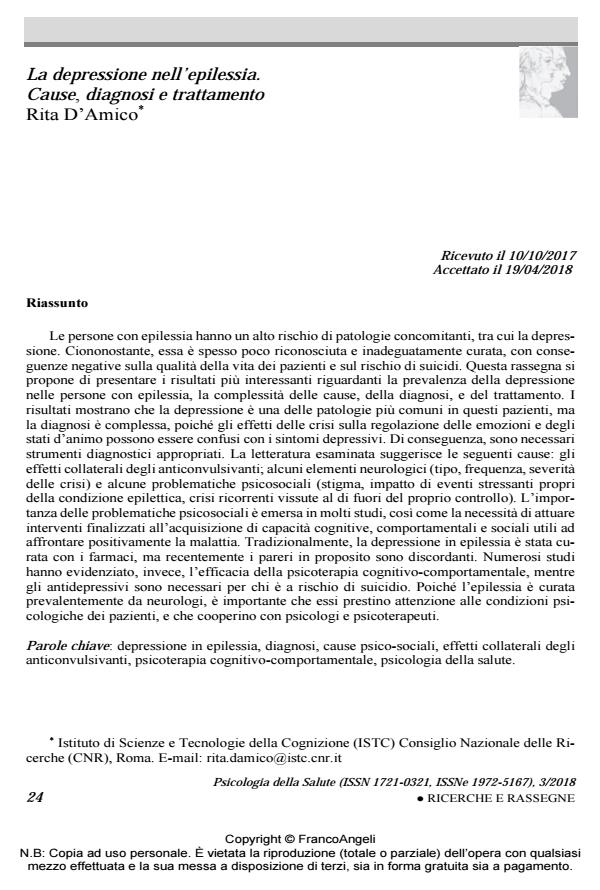Depression in epilepsy: Etiology, diagnosis and treatment
Journal title PSICOLOGIA DELLA SALUTE
Author/s Rita D’Amico
Publishing Year 2018 Issue 2018/3
Language Italian Pages 20 P. 24-43 File size 251 KB
DOI 10.3280/PDS2018-003002
DOI is like a bar code for intellectual property: to have more infomation
click here
Below, you can see the article first page
If you want to buy this article in PDF format, you can do it, following the instructions to buy download credits

FrancoAngeli is member of Publishers International Linking Association, Inc (PILA), a not-for-profit association which run the CrossRef service enabling links to and from online scholarly content.
People with epilepsy have a high risk of comorbid diseases, including depression. Nev-ertheless, depression is often poorly recognized and inadequately treated, with negative con-sequences on patients’ quality of life and the risk of suicide. This review of literature aims to present the most interesting results regarding the prevalence of depression in people with epilepsy, the complexity of causes, diagnosis and treatment. The results show that depression is one of the most common disorders in epilepsy patients, but the diagnosis is complex, as the effects of the crisis on emotion regulation and mood states can be confused with depressive symptoms. Accordingly, particularly important is the use of appropriate diagnostic tools. The literature reviewed suggests the following causes: the side effects of anticonvulsants; some neurological elements (type, frequency, severity of the crises) and some psychosocial issues (stigma, impact of stressful events of the epileptic condition, recurrent crisis experienced as unforeseeable and uncontrollable events). The importance of psychosocial issues has emerged in many studies, as well as the need for interventions aimed at acquiring cognitive, behavioral and social skills useful for dealing positively with the disease. Traditionally, the management of depression in epilepsy has involved drug treatments, but recently the opinions in this regard are discordant. Instead, numerous studies have highlighted the effectiveness of cognitive-behavioral psychotherapy. Antidepressants are especially recommended for those at risk of suicide. Since epilepsy is mainly treated by neurologists, it is important for them to pay attention to their patients’ psychological conditions, and to cooperate with psychologists and psychotherapists.
Keywords: Depression in epilepsy, diagnosis, psychosocial causes, side effects of antiepileptic drugs, psychotherapy, health psychology
Rita D’Amico, La depressione nell’epilessia. Cause, diagnosi e trattamento in "PSICOLOGIA DELLA SALUTE" 3/2018, pp 24-43, DOI: 10.3280/PDS2018-003002